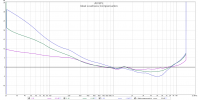Hi guys
I currently use a Cambridge audio CXA60 to drive my FS247 ELAC speakers.
But I've always felt that the sound is flat and could open up more. I only listen at around 20-25% of the volume. It's only when I dial the volume way higher, that the sound really shines.
I would like a warmer and fuller sound at low volume, with clarity and strong imaging.
Should I be pairing the speakers with a different amplifier or perhaps a stronger one? What would you guys suggest?
Thanks
Philip
I currently use a Cambridge audio CXA60 to drive my FS247 ELAC speakers.
But I've always felt that the sound is flat and could open up more. I only listen at around 20-25% of the volume. It's only when I dial the volume way higher, that the sound really shines.
I would like a warmer and fuller sound at low volume, with clarity and strong imaging.
Should I be pairing the speakers with a different amplifier or perhaps a stronger one? What would you guys suggest?
Thanks
Philip


